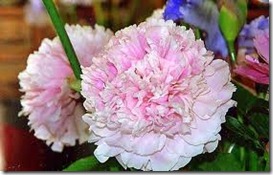Peonies are perennial plants with large, showy blooms of black, pink, purple, red, white and yellow. Peonies are susceptible to few pests or problems, but some fungi, viruses and insects can cause problems with the plant. Peonies naturally resist fungal, viral and pest infections and infestations when they are healthy, so proper fertilization and watering habits help prevent infections before they can overwhelm the plant. When caught early, cut away only the diseased or damaged areas and potentially save the plant. Long-term infections destroy the plant and spread to surrounding plantings.
Insect Infestations
-
Scales and ants feed on peony plants. Scales infest the stalks and leaves, blending in with the stem’s bark. These insects attach themselves to the stems and leave a white scar when they leave. They cause stunted growth and can cause the plant to wilt and die. Use horticulture oils to manage a scale infestation. Ants are attracted to the sugary secretions of the peony flowers but do not harm the plants.
Fungal Infections
-
Fungal infections are the most common problems peony plants suffer. Water the plants at the soil level instead of over the canopy, Prune to thin the plant and increase air flow between the stems, remove spent blooms. Sanitizing pruning shears with rubbing alcohol prevents fungal infection spread. When a plant is severely infected, cut the plant to the ground and dispose of the infected material far from any other vegetation. For smaller infections, cut away only the diseased portions of the plant. Peonies are most susceptible to Botrytis blight, Phytophthora blight, leaf and stem spots, Verticillium wilt and white mold.
Viral Infections
-
Ringspot, mosaic, leaf curl and crown elongation are viral infections that affect peony plants. There are no effective treatments for viral infections. The only recourse is to destroy severely infected plants. Viruses cause leaf spotting, curling leaves, stunted growth and lack of blooming. In some cases, the peony will bloom and behave normally with the exception of slightly discolored leaves. Remove infected plants at the end of the blooming season, or immediately if the infection is severe and nearby plants are not yet infected and discard them. Do not place any infected plant material in a compost pile because it will contaminate the compost and lead to continued infection in new plants.
No Flowering
-
Nonflowering plants are the most common peony problem and it has several causes. Only healthy peonies bloom, so insect infestations and diseases affect blooming. Excess nitrogen in the soil, as well as phosphorus and potassium deficiencies, also adversely affect blooming. Correct these problems with the addition or elimination of fertilizer. A late spring freeze destroys the peony’s buds, reducing the number of blooms for the current season. Other reasons for decreased blooming include planting too deeply, too little sunlight, overcrowding, competing plants and the plant’s age.


Deprecated: strpos(): Passing null to parameter #1 ($haystack) of type string is deprecated in /home/agriviek8Qv/agriviet.net/public_html/wp-includes/comment-template.php on line 2522